Sun Woo

The Trip, 2022
Exploring the intersection of technology and the human experience
Sun Woo (b. 1994, Seoul, South Korea) is a visual artist whose work embodies the intersection between two cultures and generations, and the way technology can inform and transform artistic practices. Born and raised in Seoul, South Korea, Sun Woo migrated to Canada around the age of ten and despite the challenges of being an immigrant, the experience of growing up between two cultures has deeply informed her identity and artistic practice, especially in a time of rapidly shifting technological landscapes.
Her compositions evoke traditional paintings with a precision almost only possible digitally. By integrating digital tools into her practice and merging them with analog approaches reflecting the generation and cultures in which she grew up, Sun Woo explores the intersection of technology and the human experience. Her work reflects the sense of in-betweenness that characterises the contemporary experience and questions the location of the body in today’s technology-filtered reality.
Sun Woo discusses with NR her upbringing, her creative process and the messages behind her recent exhibitions. She explores how her experience growing up between two cultures has influenced her work, why she chooses to use a combination of traditional and digital techniques, what she hopes to convey through her art and her perspective on the merging of cultures and technology in contemporary art.
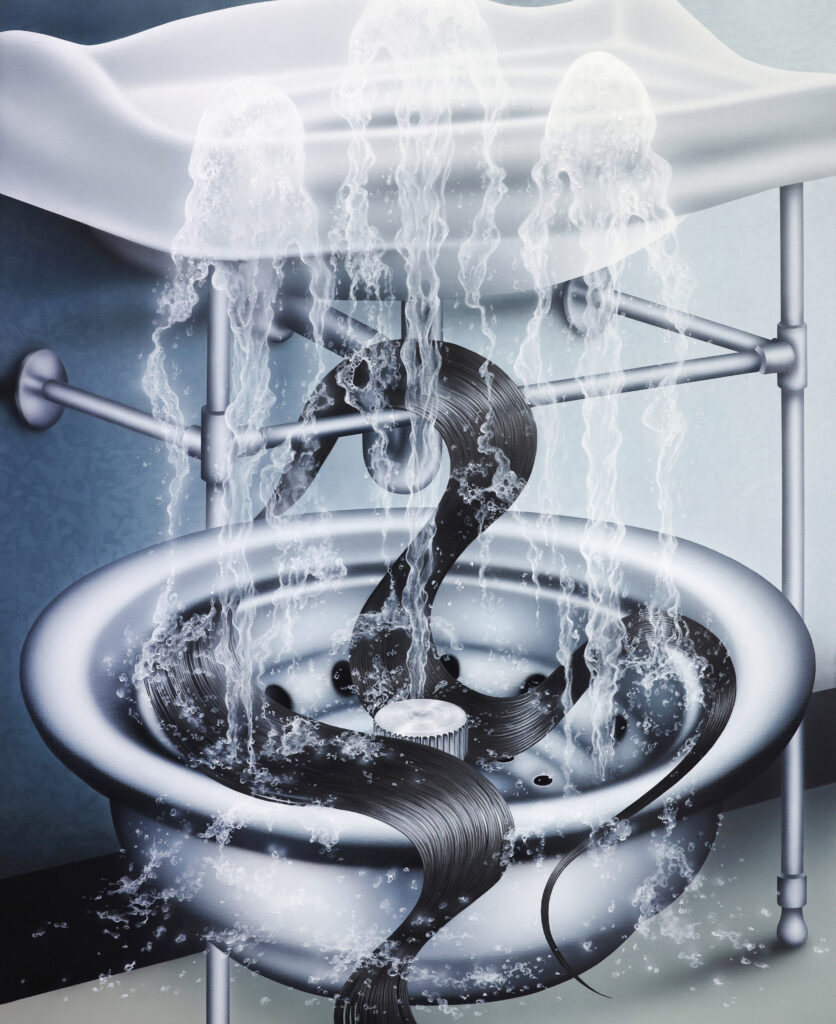
Fountain of Secrets, 2022
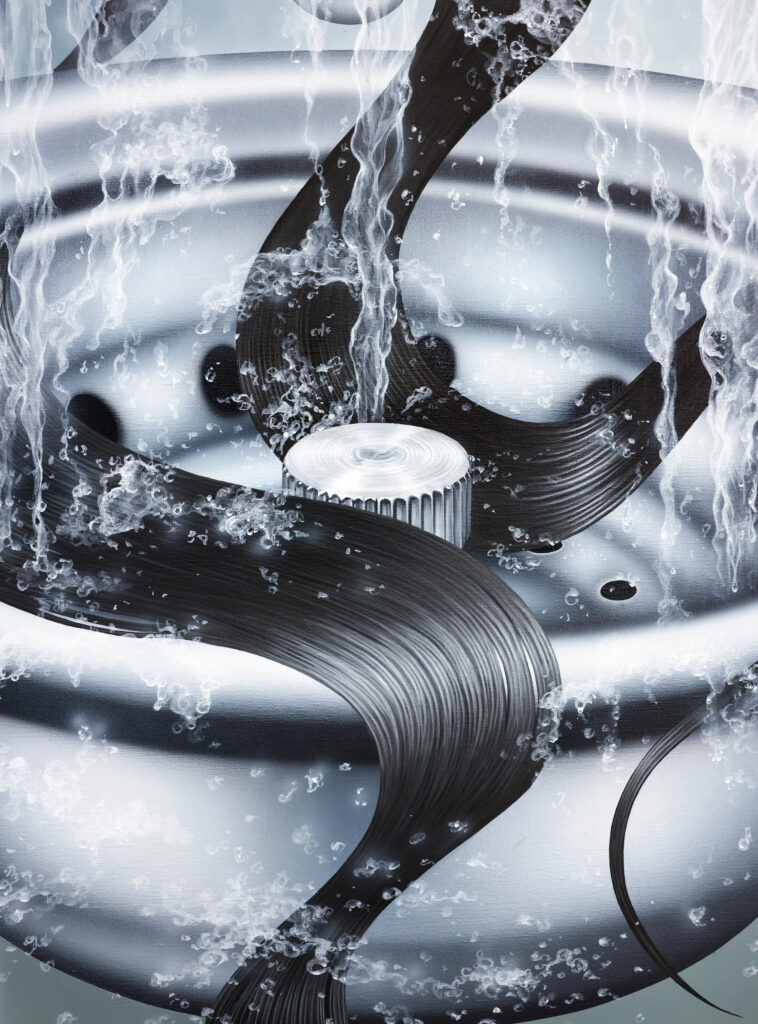
You were born and raised in Seoul, South Korea but left for Canada around the age of ten. What are your earliest childhood memories there after migrating? How did those two places aliment your desire to create and paint?
When did you start creating? When did you realise this was something you wanted to pursue?
Moving to Canada was not an easy experience as I had to leave my life at home behind and adjust to a completely new environment. Even in the company of friends, I constantly felt alone and never fully understood, which naturally led me to seek other things that could help fill these holes. These first became movies and magazines rented from my aunt who ran a small variety store in town, and later on, new devices such as computers and online platforms began to emerge. They allowed me to remain connected to my community in Seoul, but the physical distance still made me feel like I didn’t belong anywhere.
«I think this kind of upbringing and the sense of groundlessness strengthened my desire to create and paint, as it gave me a voice that was free linguistic and cultural barriers.»
When I moved to New York to attend college, I began to pursue my practice more seriously. Placing myself in a community of artists triggered me to dive into art making as something I’d like to continue to pursue. So after receiving my degree, I moved back and got a studio in Seoul, which is where I’ve been based since then.
What would you say has been most impactful from the merge of these two cultures? Is there one you feel more strongly attached to?
Your compositions evoke traditional paintings but with a precision almost only possible digitally. Airbrushing, hand painting, photoshop are some of the traditional techniques and digital tools you use for your artworks. Why have you chosen those? How do you think technology and analogue coexist together?
I think both my identity and practice have been heavily informed by the experience of growing up in between two cultures and generations. Being an immigrant in a time of rapidly shifting technological landscape allowed me to reach my homeland any time through the screen, while staying physically tied to the cultures of a foreign country. At first, it was difficult since I was born before these devices were introduced and had to teach myself how to utilise them. But they gradually became an intimate part of me, both as a friend and a channel into the world beyond physical bounds. This experience naturally led me to integrate digital tools into my practice, merging them with analog approaches as a way of talking about the generation and cultures in which I grew up. Through this process, I also wanted to reflect on the time that we’re living in, the sense of in-betweenness that comprises a large part of the contemporary experience.
«I often find that my identity bears resemblance to today’s digital images — the way they wander without an anchor.»
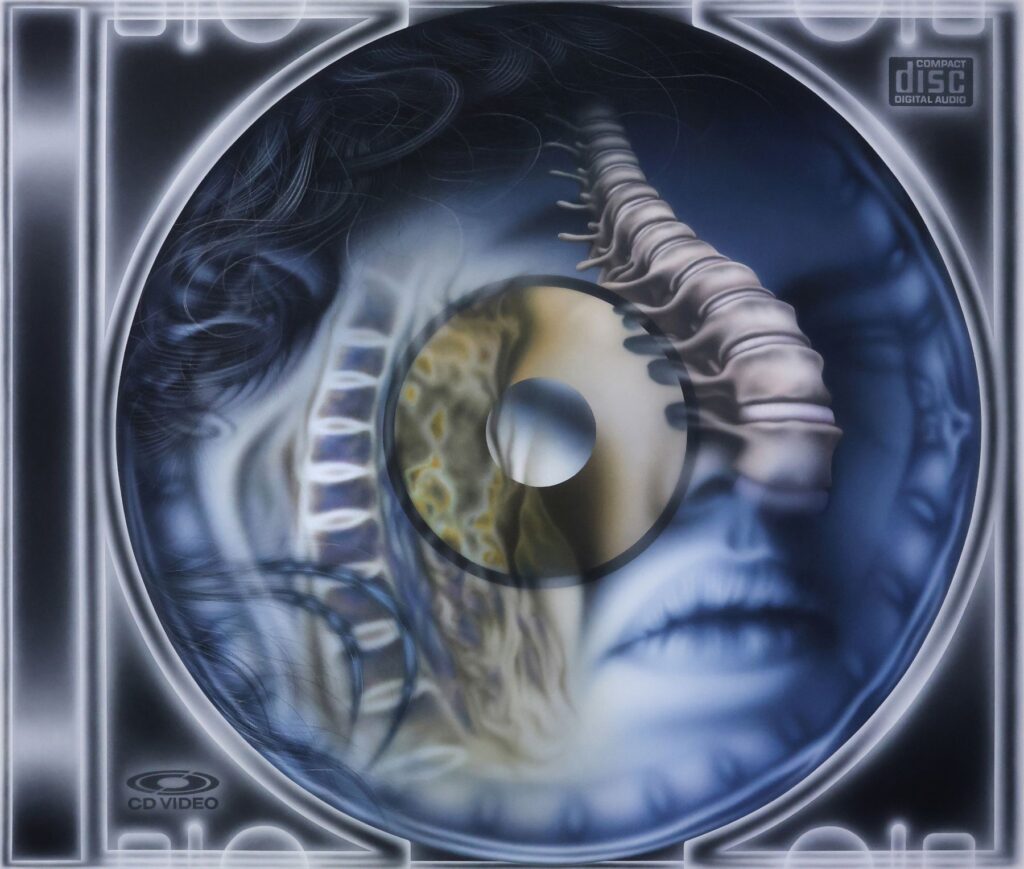
Circuit of Requiem, 2022
On one hand, I think this sense of empathy drives my urge to take these images out of the screen and ground them in the physical space of a painting. Because I imagine them as virtual bodies floating in the online environment, the process of distorting and augmenting them on Photoshop reflects my interest in exploring the transformative aspect of contemporary body, fostered by its increasing interaction with technology. By bringing them out of the web, giving them a tangible form through bodily labor, and putting them back on the Internet, I’m trying to question the location of today’s body — including my own — especially after much of our activities have transitioned into the digital sphere after the pandemic.
Could you tell us about your show ‘Memory of Rib’ curated by Jeppe Ugelvig with a special screening of Theresa Hak Kyung Cha’s Mouth to Mouth (1975) and your show ‘Invisible sensations’ at Carl Kostyal in Milan in May 2022? What were the messages behind these exhibitions?
‘Memory of Rib’ was a show that brought together a group of artists whose works evoke or deal with the idea of corporeality. It explored concepts like the body’s instability, limitations and contingency by looking at the ways in which it interacts with today’s technology and sociopolitical landscape, while also thinking about how we detect and identify with images of the flesh seen in commodities and media. It included a diverse range of artists in terms of age, sexual identity and cultural background, especially with Theresa Hak Kyung Cha, whose work from 1975 provided a historical anchor to which younger generations of artists could contribute their discourse.
The works that I presented in the show, titled Silent Companions and Baggage, developed from my research on prosthetics and medieval armours and weapons — tools that have evolved to complement physical weaknesses and came to function as literal arms, legs, and skins of an individual.
«Weaving these histories with the relationship between today’s body and technology, I tried to construct compositions in which the organic intersects or collides with the mechanic to become something transcendental.»
Through images like melting meat-candles and strapped rock-flesh, I tried to address how it feels to be a body in a digitally mediated world, which at once “enhances” you and nurtures your feeling of insufficiency.
‘Invisible Sensations’ was my solo show that opened earlier that year, and it also dealt with the emotions and sensations related to inhabiting a technology-filtered reality. It included paintings and 3D-printed sculptures that evoke body’s limits, vulnerabilities, and struggles to resist their mortal fate, as well as social constraints that continue to oppress the female and coloured body. Images of my own body parts, including medical scans that I carried with me at the time to treat a prolonged illness, were collaged with elements that allude to mechanical presence, becoming fragmented, reconstructed, and translated into otherworldly beings. Through this convergence, I tried to look into the fragility and endurance of today’s bodies and question the extent to which their unification with technology can liberate them or transform the atmosphere they inhabit.
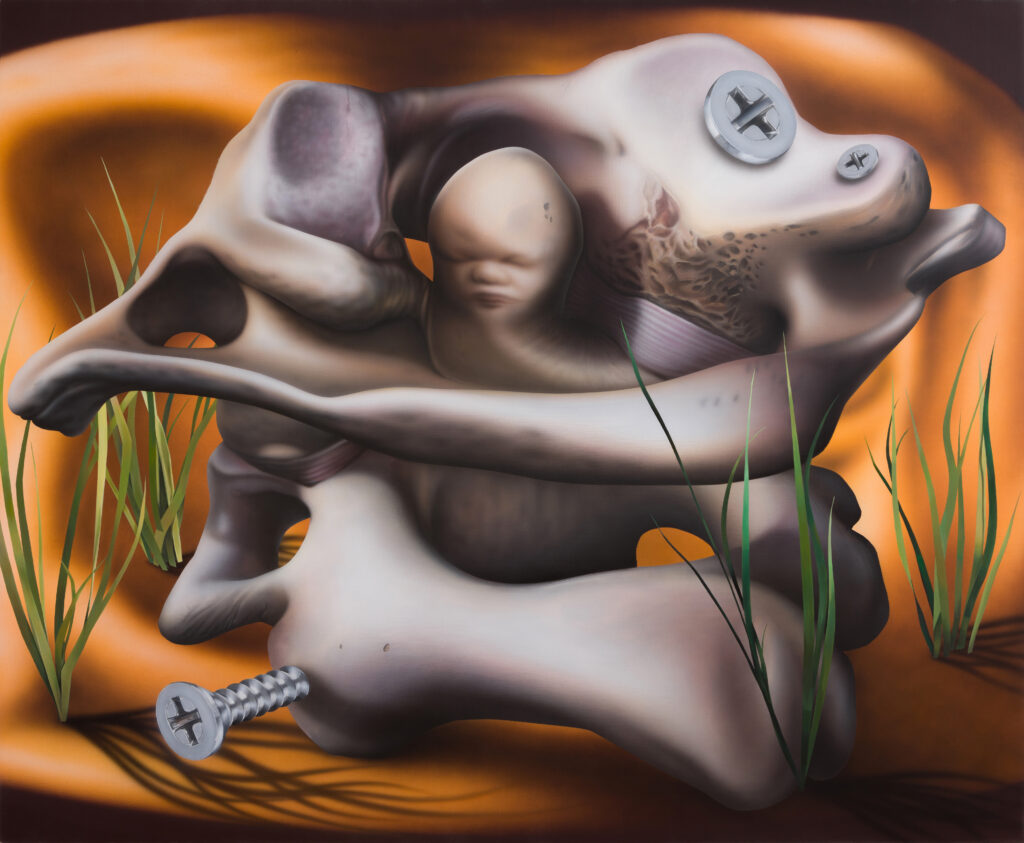
Diligent Heart, 2022
How is the process usually for you when putting together a solo show?
In my past interviews, I’ve revealed that I collage images via Photoshop. But even though my works are presented as images, they actually begin with text. From stories to dissertations, various sources of written materials provide inspiration for my work. Despite this, I am interested in creating something that can only be communicated by being in the presence of my works — something that is to be experienced and surpasses the written language.
«Paintings are not simply re-enactments or something that fits perfectly into an existing theoretical frame, but they are a result of materials that I channel through my own body and create to evoke a response that cannot be fully harnessed by rationality.»
Sometimes, the exhibition space also determines what I decide to paint, even when it’s a white cube. It is important to me that the works speak to the space and vice versa, and that the work is presented in a way that reinforces the viewing experience. As a result, I tend to spend a lot of time contemplating on such a dynamic, which often determines the work’s size and form.



Detail crops from The Crimson Letter (Triptych), 2022
Your work also interrogates Korean societal desires and more specifically the ways in which female bodies are viewed and represented. Could you talk more about that? How do you think gender roles and stereotypes surrounding being a woman in Korea, will evolve?
Because my practice interrogates today’s social condition and technological landscape through the lens of my own psychological and bodily experience, many of my works are inevitably tied to my identity as a Korean woman. In result, they often speak to the experience of being a female body in both online and offline environment, as well as a body inhabiting two different cultures.
In addition to my painting practice, I’ve also been working on a project called Dadboyclub with an artist and friend, Sangmin Lee since 2021. Dadboyclub, to both of us, is a platform to channel issues specifically regarding the experience of being a woman. For the first iteration of our project, we exhibited virtual ‘products’ that each house a story about womanhood. Objects like an inflating, studded baby pacifier that obstructs a woman’s throat, or a ‘flower’ with a rolling eye that detects and destroys hidden-cameras with automated spears, reveal the conditions and violence women may experience in society through a long-winded joke. These products do not actually exist, in real life nor as NFTs — so they cannot be sold — which was an important aspect of this ‘virtual store,’ which was also a commentary on how female narratives embodying pain are consumed as entertainment online or through popular media.
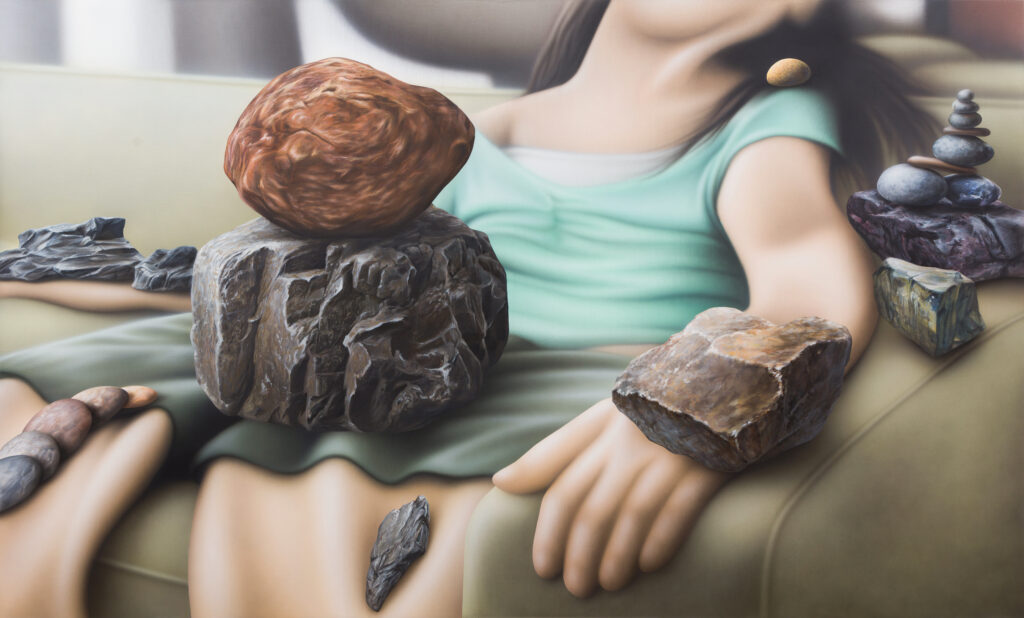
Sinkage, 2022
Absurdity is a driving force of this practice, as we navigate the ways we can express our discontent with inequality as well as emotional pain that is regarded as superfluous. Whether it be a small feeling from a failed relationship, to discovering violence embedded in the myth of Psyche and Eros — Dadboyclub re-situates women’s stories, old and new, revealing a prickling truth of reality that was often disregarded as minute and obsolete. We believe the personal is political.
There have been some progressive developments over the past few years regarding gender issues in Korean society. There has been a change of perspective regarding parenting and housekeeping especially, which have been regarded as female duties up until very recently. More women are speaking up about sexual violence and trauma, which have been looked down upon before the Me Too Movement in Korea. But at the same time, there still remains a local issue of victim-shaming and the taboo of publicly claiming yourself a feminist, grounded in the society’s age-old history of Confucian patriarchy.
«Discussions regarding female equality are voiced more often, but with the growing polarisation between a progressive agenda and right-wing counter-movements — which seems to be a global phenomenon — the backlash hits harder, making it difficult to gauge whether we are moving forward or simply repeating the past.»
Which other mediums and tools would you like to explore? Would you consider using AI systems such as DALL·E?
Actually, my current practice already involves AI in a way, since I often use images that are fed to me by my search engine and social media — which, after analysing and machine-learning my interests, provide me with new sources. In this sense, I often allow my devices to become the agent rather than controlling all aspect of the process, and the resulting work becomes a joint product of these voluntary and involuntary selections. Even so, I sometimes find new programs like DALL-E quite haunting. How do artists justify their practice when AIs actually produce artworks on behalf of them? What new roles are we to take on?

Detail crop from Diligent Heart, 2022
There is a certain longing for the 2000s in your work. Is there any recent pop culture events that has marked you? What are some of your favourite music albums and films?
I think my works embody a sense of longing and empathy in general, not only for the 2000s but also an older past or even the future. They sometimes long for a certain time, place, or person that I’ve physically experienced but also ones that I haven’t. I find this faux-nostalgia, a longing for a time that I do not know, to be an interesting cultural phenomenon that I also engage in. In this sense, the convergence of the physical and virtual plays not only into the process and medium with which I work, but is also echoed throughout the narratives and depictions that drive the work.
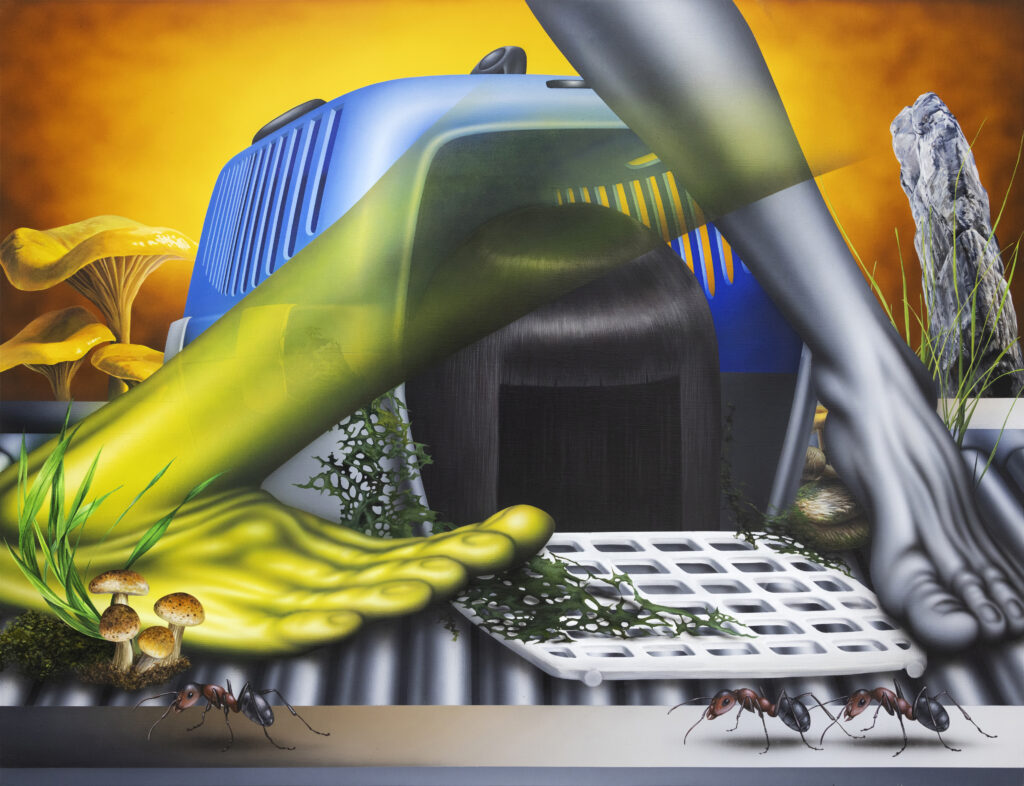
No-landing Flight, 2022
How do you feel our hyper consumption of media is shaping us? Do you think we risk to lose ourselves if less time is spent on building connections or do you think it is an inherent part of shaping our identity?
In this new age of technology, how do you ground yourself?
I also find it hard to navigate a time like this, where you’re seeing so much and being surrounded by so many people, especially through social media. From a certain angle, I feel like the world seemed much smaller when we were less connected, as it gave each of us more presence and weight. Now it seems to be the other way around. Our sense of importance seems to dwindle as we become exposed to the lives of so many strangers and ours constantly displayed alongside theirs. We’re endowed with more options of things to see and people to meet than ever, but simultaneously, we also become one of those options as well. These are some of the things that I’ve been thinking about lately, and how do I ground myself in an age like this? I still don’t have an answer to that.
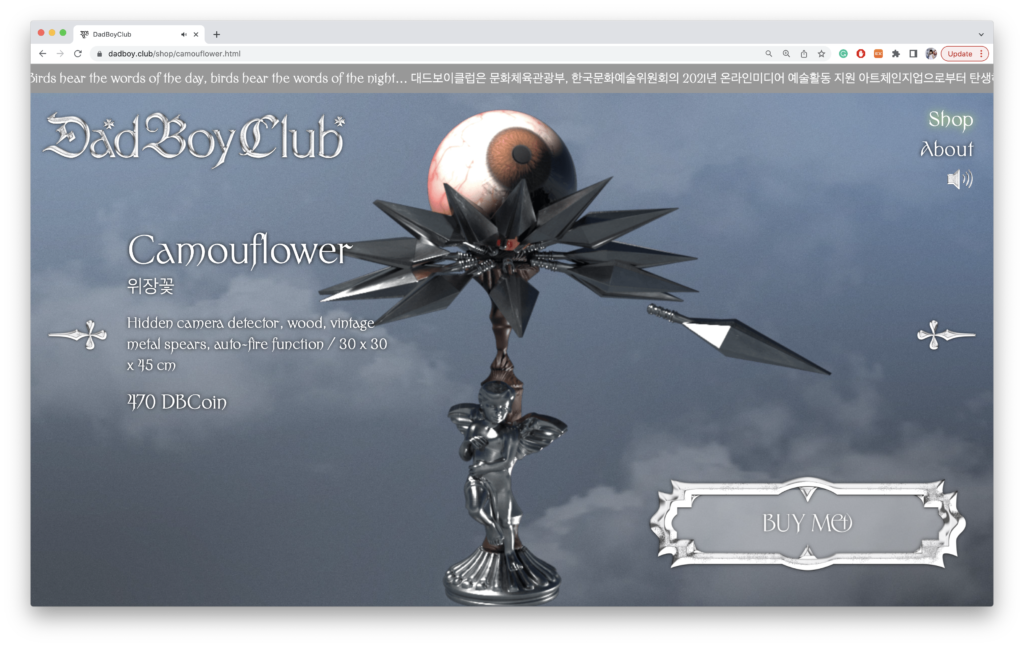
Dadboyclub, Camouflower, 2022. Website
What was the first piece of art you saw that left an impression on you?
Francis Bacon and Louise Bourgeois were among the very first, and they still continue to inspire my practice.
Credits
Artworks · Courtesy of the artist and Carl Kostyál Milan, London, Stockholm.